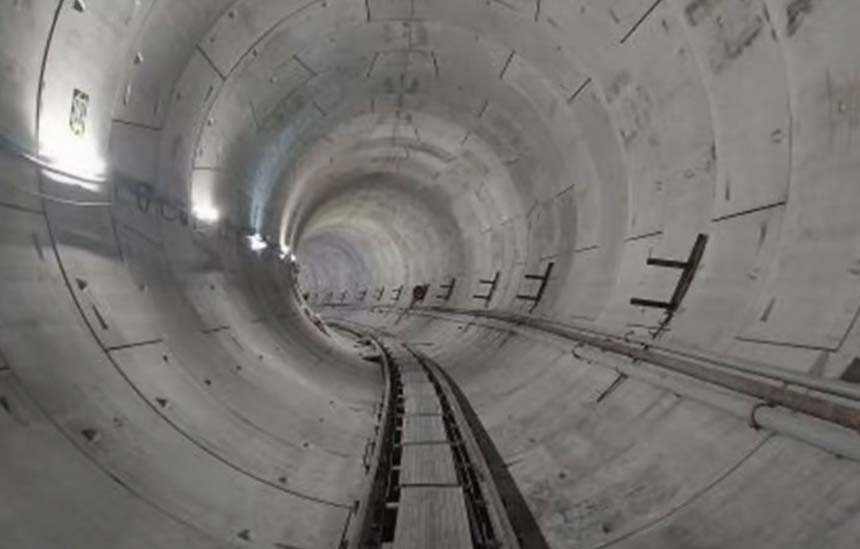PUB, Singapore’s National Water Agency, has concluded tunnelling works for the second phase of the Deep Tunnel Sewerage System (DTSS), which brings us a significant step closer to the full completion of a major used water infrastructure that will boost water recycling and enhance Singapore’s long-term water sustainability.
A ceremony to mark this important milestone was attended by Ms Grace Fu, Minister for Sustainability and the Environment, and more than 300 guests including pioneer engineers who started the DTSS project more than two decades ago.
Phase 2 of the DTSS involves the construction of a 98km-long network of deep tunnels and link sewers, as well as the future Tuas Water Reclamation Plant. These new infrastructure components extend the DTSS network to serve the western half of Singapore, including the downtown area and upcoming developments such as Tengah Town and Jurong Lake District. Spanning multiple tunnelling and construction contracts, the DTSS Phase 2 project involved over 5,000 workers at the peak of its construction works.
Evolution of Singapore’s used water management
Conceived in the 1990s to transform the country’s used water management system, the DTSS is a massive underground project designed to meet Singapore’s long-term needs for used water collection, treatment, reclamation, and discharge. It holds the key to enable PUB to reclaim and recycle water in an endless cycle, thus boosting our capacity to produce NEWater, Singapore’s third National Tap and a weather-resilient source of water.
Prior to the DTSS, Singapore was divided into six used water catchment zones, each served by a Water Reclamation Plant (WRP) and a total of over 130 pumping stations across the island. These pumping stations were needed to convey used water to the WRPs for treatment before the treated effluent was discharged to the sea. As Singapore’s population and economy grew rapidly, the Government sought a more cost- and land-efficient solution for used water management.
The implementation of the entire DTSS will allow PUB to reduce the overall land footprint of the used water system across Singapore by half
Over two phases, the DTSS comprises a 206km-long network of deep tunnels and link sewers that will convey used water entirely via gravity to three centralised water reclamation plants located in Changi, Kranji and Tuas. The conveyance of used water via gravity instead of energy-intensive pumping stations enhances the robustness and reliability of the used water collection system. This also eliminates the risk of pollution in our rainwater catchments. The implementation of the entire DTSS will allow PUB to reduce the overall land footprint of the used water system across Singapore by half, freeing up to 150 hectares of land (nearly twice the size of the sprawling Singapore Botanic Gardens) for higher-value land use.
Mr Goh Si Hou, PUB’s Chief Executive said, “As one of the most water-stressed countries in the world, the ability to effectively collect and recycle our used water in a closed water loop has been a game-changer in our quest for water security. The Deep Tunnel Sewerage System is not only an engineering feat, but a key pillar in strengthening Singapore’s water resilience to meet the long-term challenges of climate change and growing water needs. This has been made possible through the bold vision and innovation of our pioneers, and decades of meticulous planning and hard work by our planners, engineers and contractors. We look forward to the upcoming completion of our Water Reclamation and NEWater plants, which will realise the full potential of the DTSS in the years to come.”
Significant investment to benefit future generations
Costing around $10 billion and designed to last for 100 years, the DTSS is an example of long-term water infrastructure planning and investment to benefit multiple generations. Due to its scale and complexity, the construction of DTSS had to be carried out in two phases.
Phase 1 of the DTSS serves the eastern half of Singapore and was completed in 2008. Tunnelling work for Phase 2, which commenced in 2019, was a challenging process through highly built-up areas that involved deep expertise and a significant amount of preparatory work. The tunnelling works had to be carried out by five different contractors, using pioneering construction methods and smart technologies for safe and smooth operations. This served to greatly reduce disruption to above-ground infrastructure and the public.
The Phase 2 project has also implemented new features to ensure the integrity of the deep tunnels and ease of maintenance. These include the use of concrete resistant to microbiological-influenced corrosion, isolation gates to allow for flow diversion, fibre optic cables for remote monitoring of a tunnel’s structural integrity, and the use of air jumpers to control air flow within the tunnels.
A key component of DTSS Phase 2 is the future Tuas Water Reclamation Plant, which will be equipped with advanced technology to treat two separate streams of domestic and industrial used water in an energy-efficient manner. When ready in 2026, Tuas WRP will be co-located with NEA’s Integrated Waste Management Facility to form Tuas Nexus, Singapore’s first integrated used water and solid waste treatment facility that will be fully energy self-sufficient.

